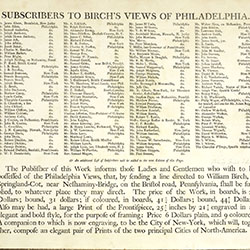 |
Subscribers to Birch’s Views of Philadelphia, 1800. Library Company of Philadelphia.
More than 150 people subscribed to the first edition of The City of Philadelphia and not surprisingly most were city residents. Merchants made up nearly half of the subscribers, while physicians, tradesmen, “gentlemen,” and government officials, among others, also purchased the views. William Barker, an engraver, Richard Folwell, a printer, and Jesse Oat, a coppersmith, who all worked with Birch on the views supported the project by purchasing subscriptions. Birch, however, failed to convince the Library Company to acquire one. |
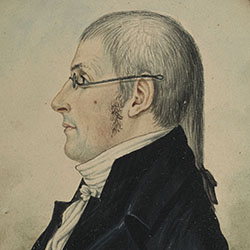 |
Attributed to William Birch, Edward Pennington, ca. 1800.Watercolor. Courtesy of the Pennsylvania Academy of the Fine Arts, Philadelphia. Gift of Bruce Gimelson.
Edward Pennington (1766-1834), proprietor of a Philadelphia sugar refinery, was one of the many merchants who subscribed to The City of Philadelphia. |
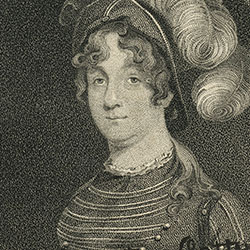 |
David Edwin, Ann Brunton Merry Wignell Warren (Philadelphia, ca. 1805).Engraving. Library Company of Philadelphia. McAllister Collection.
Famed British actress Ann Brunton Merry (1769-1808) was one of only two female subscribers to The City of Philadelphia. She had moved to Philadelphia in 1796 after accepting an offer to perform at the Chestnut Street Theater, a building featured in one of Birch’s views. |
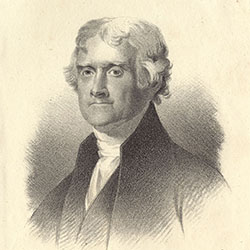 |
After Gilbert Stuart, Th. Jefferson (Philadelphia: Childs & Inman, ca. 1833). Lithograph. Library Company of Philadelphia. McAllister Collection.
Birch recalled in his autobiography that Thomas Jefferson (1743-1826) kept a copy of the City of Philadelphia close at hand throughout his presidency. “It layed [sic] on the sophia [sofa] in his Visiting Room at Washington til it became ragged and dirty, but was not suffered to be taken away,” wrote Birch. |
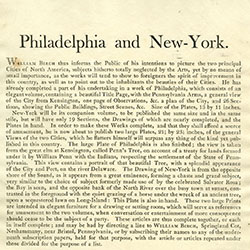 |
Philadelphia and New York. (Philadelphia, ca. 1800). Broadside. Library Company of Philadelphia.
Here William Birch announces his intention of publishing a set of engraved views of both New York City and Philadelphia, projects in varying stages of completion in 1800. To increase interest in the sets, he published a larger engraving representing each city “intended as elegant furniture for a drawing or setting room, which will serve as references for amusement to the two volumes.” |
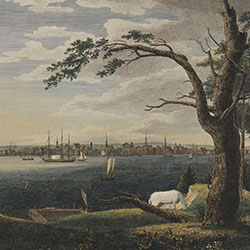 |
Samuel Seymour after William Birch, The City of New York in the State of New York, North America. (Springland, near Bristol, Pennsylvania: W. Birch, 1803). Hand-colored engraving. First state. Historical Society of Pennsylvania. |
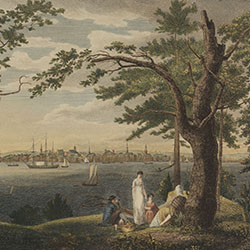 |
Samuel Seymour after William Birch, The City of New York in the State of New York, North America. (Springland, near Bristol, Pennsylvania: W. Birch, 1803). Hand-colored engraving. Second state. Historical Society of Pennsylvania.
Despite his stated intentions, William Birch never published a set of New York City views. “I had nearly completed a sett of Drawings of that City which I me[a]nt to publish as a companion Vollum to the Philadelphia,” he wrote, “but found the profits of the undertaking was not equal to the expence [sic] of travelling and the support of my family.” However, three different states of this view of lower Manhattan from Brooklyn were created. In the second and third states, Birch has wisely replaced the dying trees seen in the first state with lush green foliage. The greenery frames the city view in the distance and a picnic party has been substituted for the solitary white horse, producing a much more animated and engaging image. |
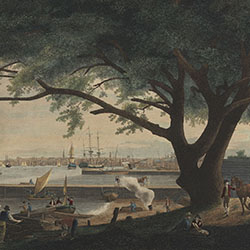 |
Samuel Seymour after Thomas Birch, The City of Philadelphia in the State of Pennsylvania, North America (Neshaminy near Bristol, Pennsylvania: Wm. Birch, 1801). Hand-colored engraving. Historical Society of Pennsylvania.
This print, very similar to the frontispiece for The City of Philadelphia view book, portrayed the city as a commercially vibrant center while also paying homage to its historical past. The prominently featured treaty tree, the supposed location of William Penn’s meeting with the local Lenni Lenape blew down within a decade. |
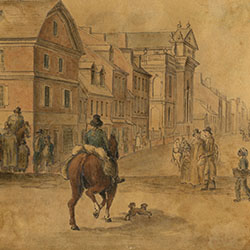 |
William or Thomas Birch, Preparatory sketch for Second Street North from Market St. wth. Christ Church. Philadelphia, ca. 1800. Watercolor. Library Company of Philadelphia. Bequest of Charles A. Poulson. |
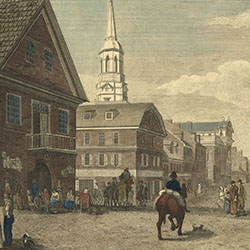 |
William Birch, Second Street North from Market St. wth. Christ Church. Philadelphia (Philadelphia: W. Birch, 1827-1828). Hand-colored engraving. Library Company of Philadelphia.
Although this print’s title draws the viewer’s attention to the venerable Christ Church and its tall steeple, the Old Courthouse and market at the left and the bustle of activity around it dominates the scene. |
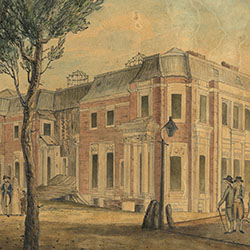 |
William or Thomas Birch, Preparatory sketch for An Unfinished House, in Chestnut Street Philadelphia, ca. 1800. Watercolor and ink. Library Company of Philadelphia. Bequest of Charles A. Poulson. |
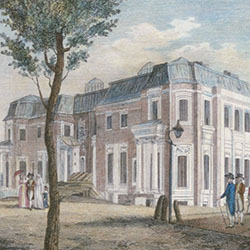 |
William and Thomas Birch, An Unfinished House, in Chestnut Street Philadelphia, (Philadelphia: W. Birch & Son, 1800). Hand-colored engraving. Library Company of Philadelphia.
For subscribers not familiar with Philadelphia, Birch’s ambiguous title, “an unfinished house,” could mean that this impressive edifice was under construction and would soon be a showcase of American style and wealth. In reality, the residence’s owner, financier Robert Morris (1734-1806) was in debtors’ prison and the house, located near Eighth Street, would soon be demolished with the building’s materials used to pay off Morris’s creditors. William Birch purchased two bas- reliefs from the house for use in his own residence Springland. Restrikes from the original printing plate were issued as late as 1860. |
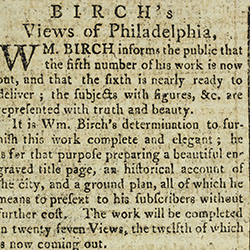 |
Advertisement for Birch’s Views of Philadelphia from Porcupine’s Gazette (Philadelphia, June 1, 1799.) Library Company of Philadelphia. |
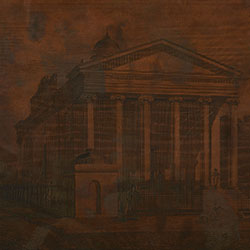
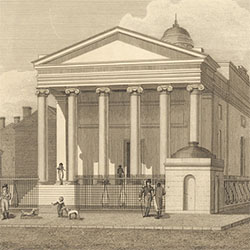
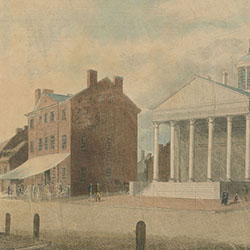
|
Copper printing plate for Bank of Pennsylvania, South Second Street Philadelphia, 1804. Library Company of Philadelphia.
W. Birch & Son, Bank of Pennsylvania, South Second Street Philadelphia (Philadelphia, ca. 1860 restrike of 1804 plate). Engraving. Library Company of Philadelphia.
William Birch, Bank of Pennsylvania, South Second Street Philadelphia (Philadelphia: W. Birch, 1800). Hand-colored engraving. Library Company of Philadelphia.
Birch created a new plate of this scene for the second edition of The City of Philadelphia published in 1804. The bank no longer shares the streetscape with the neighboring City Tavern. Focusing on the bank, recently completed in 1801 after the designs of Benjamin Henry Latrobe (1764-1820), allowed Birch to more accurately depict the architectural features of this important Greek Revival style building. |

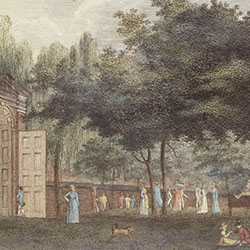
|
William or Thomas Birch, Preparatory sketch for State-House Garden, Philadelphia, ca. 1798. Watercolor and ink. Library Company of Philadelphia. Bequest of Charles A. Poulson.
W. Birch & Son, State-House Garden, Philadelphia. (Philadelphia: R. Campbell & Co., 1798). Hand-colored engraving. Library Company of Philadelphia.
Four of Birch’s city views depict the buildings or grounds where federal, state, and local governmental power resided during the 1790s. Fewer people and dogs appear in this engraving than the watercolor, but the gardens are still presented as an appealing green space attracting well-dressed men, women, and children, and one romping canine. |
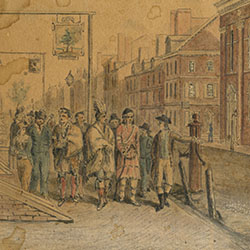
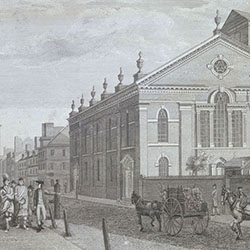
|
William or Thomas Birch, Preparatory sketch for New Lutheran Church, in Fourth Street Philadelphia, ca. 1800. Watercolor. Library Company of Philadelphia.
William Birch, New Lutheran Church, in Fourth Street Philadelphia ([Philadelphia]: W. Birch, [1804]). Engraving. Library Company of Philadelphia.
Birch’s city views embodied not only “the most general idea of the town,” but also represented specific moments. This one captures Indigenous men being given a tour by a guide, sometimes identified as minister and politician Frederick Augustus Muhlenberg (1750-1801), who points out the Lutheran Church, recently rebuilt after a devastating fire in 1794.The City of Philadelphia also included a view of the original Lutheran Church a block away. |
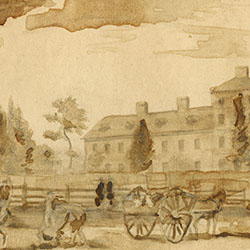

|
William or Thomas Birch, Preparatory sketch for Alms House in Spruce Street Philadelphia, ca. 1799. Watercolor. Library Company of Philadelphia.
W. Birch & Son, Alms House in Spruce Street Philadelphia (Philadelphia: W. Birch & Son, 1799). Engraving. Library Company of Philadelphia.
Even in this most preliminary of sketches, all of the elements for the final print are in place, from the recalcitrant pig to the two large institutional buildings behind the high wall. Oddly, the House of Employment, the more prominent of the two buildings depicted, is not mentioned in the engraving’s title. With the exception of the waterworks at Centre Square, this site between Tenth and Eleventh streets is the most western view of the city rendered by Birch. |
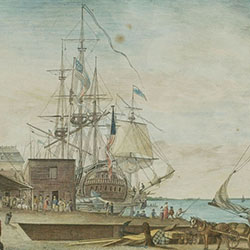
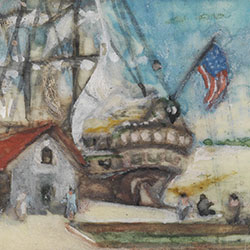
|
William Birch, Arch Street Ferry, Philadelphia (Springland near Bristol, Pennsylvania: W. Birch, 1800). Hand-colored engraving. Library Company of Philadelphia.
William Birch, Arch Street Ferry, March 1801. Watercolor on ivory. Courtesy of the Pennsylvania Academy of the Fine Arts. Bequest of Constance A. Jones.
As can be seen in the Bank of Pennsylvania print, Birch sometimes returned to the same scene to alter his original depiction. Birch may have gone back to the bustling dock area intending to modify his original engraving for the second edition of The City of Philadelphia (1804). Ultimately, he decided to include the original image. |
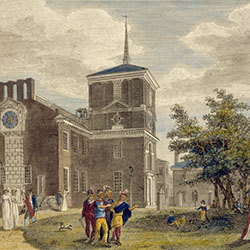
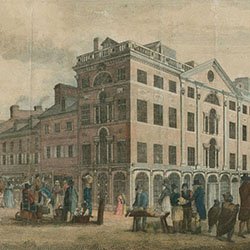
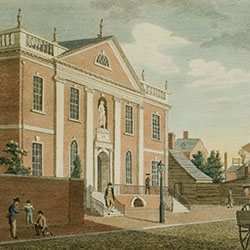
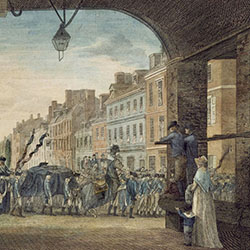
|
William Birch, Back of the State House, Philadelphia (Philadelphia: W. Birch, 1827-1828). Hand-colored engraving. Library Company of Philadelphia.
W. Birch & Son, South East Corner of Third, and Market Streets, Philadelphia (Philadelphia: W. Birch & Son, 1799). Hand-colored engraving. Library Company of Philadelphia.
William Birch, Library and Surgeons Hall, in Fifth Street Philadelphia (Philadelphia: William Birch, 1800). Hand-colored engraving. Private Collection.
William Birch, High Street, from the Country Marketplace Philadelphia (Philadelphia: W. Birch, 1804). Hand-colored engraving. Library Company of Philadelphia.
One of the most notable features of Birch’s city views is their lively depiction of many different kinds of street life. Here we see a delegation of Indigenous people visiting Independence Hall (which then had a temporary replacement steeple); vendors hawking their wares in front of a the city’s most opulent commercial building; George Washington funeral procession passing by the shed of the country market; and beggars accosting a man right in front of the Library Company. |




























